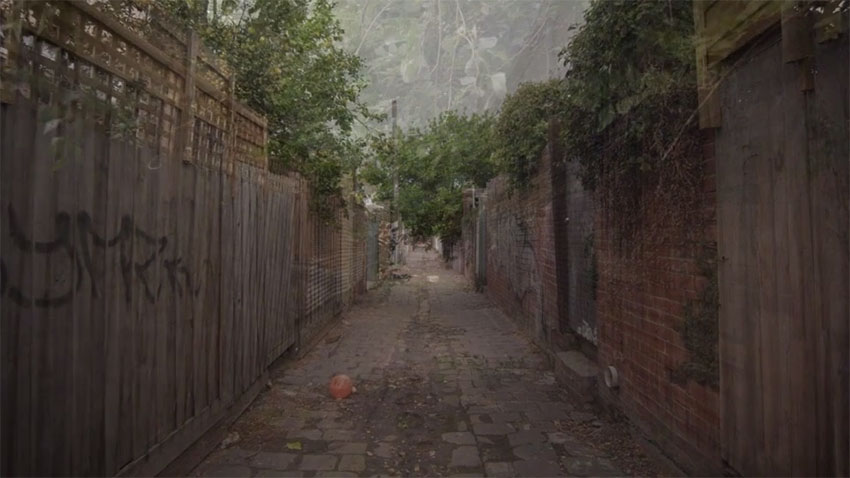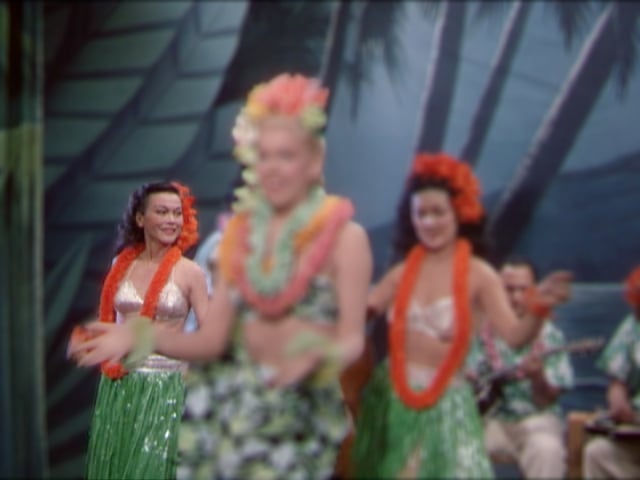
© » KADIST
Charles Avery
Drawing & Print (Drawing & Print)
Since 2005, Charles Avery has devoted his practice to the perpetual description of a fictional island. Replete with its own population and constantly shifting topography, Avery’s intricately conceived project amounts to an ever-expanding body of drawings, sculptures, installations and texts which evince the island. Exhibited incrementally these heterogeneous elements serve as terms within the unifying structure of the island – as multiple emissions of an imaginary state, and as a meditation on the central themes of philosophy and the problems of art-making.

© » KADIST
Carla Zaccagnini
This series of photographs, Sobre la igualdad y las diferencias: casas gemelas (On Equality and Differences: Twin Houses) , taken in Havana in 2005, belongs to a wider group of works that the artist has been developing over many years, generally titled Bifurcaciones y encrucijadas (Forking Paths and Crossroads) . These works are dedicated to the collection and investigation of similarities and singularities. Some focus on things that are supposed or expected to be identical, but end up being slightly different.

© » KADIST
Miljohn Ruperto
Acting Exercise: Demon Possession is a video by Miljohn Ruperto that addresses notions of performativity, the self, and collective truth. Set in an empty, derelict room with nothing but an old mattress on the floor, the film features a series of actors independently performing a demonic possession, or at least their interpretation of what one would look like. Although each reenactment is slightly different, actor after actor, the viewer is confronted with a common thread: a near archetypal response that binds them all together.

© » KADIST
David Maljkovic
This video was filmed in the middle of the Zagreb fair which took place in the 1960s and 1970s under the rule of Tito. Tito created the fair to signify the exemplary economic exchange between the East and West. The film’s setting takes place at the Italian pavilion, where several young people are seen sitting in cars, trying to repeat sentences in English.

© » KADIST
Miljohn Ruperto
Miljohn Ruperto’s research-based multidisciplinary practice often deals with possession, re-enactment, mythology and archives. These conceptual throughlines also underpin Ruperto and Minnesota-based director Rini Yun Keagy’s eerie experimental documentary Ordinal (SW/NE) , which collapses mythology, scientific research, Californian agricultural history, American literature, and speculative fiction into a poetic and timely examination of possession, infection, and individual agency in an age of wanton industrial agriculture and alienation. Ordinal (SW/NE) tells the tale of a young Black man named Josiah as he navigates the banalities of daily life while potentially being possessed by a malignant supernatural force or stricken by valley fever, a little-known yet gruesome and sometimes lethal real-life respiratory illness which disproportionately affects farm and field workers, particularly Filipinos and African-Americans.

© » KADIST
Mario Ybarra Jr.
Ammo Bunker (2009) is a multipart installation that includes large-scale wall prints and an architectural model. The work takes as its departure point the history of Wilmington, Ybarra’s native hometown in southern Los Angeles. The piece refers to a Civil War era ammunition store that Ybarra found at the heart of the harbor close to Long Beach.

© » KADIST
Clarissa Tossin
In Fordlândia Fieldwork (2012), Tossin documents the remains of Henry Ford’s rubber enterprise Fordlândia, built in 1928 in the Brazilian Amazon to export cultivated rubber for the booming automobile industry. When his rubber trees died from disease and his primarily indigenous workforce revolted, his enterprise went busts within a few short years. Ford never faulted his own planning, but instead blamed the “inhospitable” Brazilian landscape.

© » KADIST
Jedediah Caesar
For Untitled, Caesar encased recycled objects such as scraps of plywood, paper or cloth in resin and then cut and reassembled the pieces into abstract forms. This technical rework allows for a clinical inspection of the material contents of the piece and the resulting slanted industrial monolith echoes minimalist sculpture, although with a different expressive texture. Indeed, Untitled can be seen as a contemporary pyramid with a painterly surface.

© » KADIST
Clarissa Tossin
Clarissa Tossin’s film Ch’u Mayaa responds to Frank Lloyd Wright’s Hollyhock House (constructed 1919–21) in Los Angeles, an example of Mayan Revival architecture. By re-appropriating the structure as a temple and imbuing it with a dance performance based on movements and postures found in ancient pottery and murals, the choreography takes its influence from the house’s design and the body positions on ancient Maya ceramics and buildings. A pulse, breathing, and a pre-Columbian clay flute are among the sounds on the soundtrack.

© » KADIST
Carla Zaccagnini
De sino à sina (From Bell to Fate) is a six-channel sound installation by Carla Zaccagnini exploring the relationship between modern Brazil and its colonial past. The sound installation is made from a recording of the bell at Capela de Nossa Senhora do Rosário dos Homens Brancos, a Baroque-style chapel that is one of the first chapels in Ouro Preto (previously Vila Rica) in the region of Minas Gerais. The work references the execution of José da Silva Xavier (1746-1792), also known as “Tiradentes”.

© » KADIST
Miljohn Ruperto
Miljohn Ruperto’s high-definition video Janus takes its name from the two-faced Roman god of duality and transitions, of beginnings and endings, gates and doorways. He is usually depicted with two faces as he looks both forward and backward, to the future and the past. The video, which is deftly animated in collaboration with Aimée de Jongh, presents a close-up of a dying “duck-rabbit,” a vivified version of an ambiguous illustration made popular by the Austrian-British philosopher Ludwig Wittgenstein in his Philosophical Investigations .

© » KADIST
Daniel Crooks
The Illusion of Everything (2014) follows an unseen pedestrian as he navigates the Australian city of Melbourne’s dense and intricate network of laneways. The video begins with the pedestrian traversing a seemingly idyllic ivy lined stone and concrete thoroughfare. As his pace begins to accelerate, the camera follows him with greater urgency, slowly settling and become stable again as his pace decelerates.

© » KADIST
Miljohn Ruperto
Miljohn Ruperto’s silent video work Appearance of Isabel Rosario Cooper is an archive of ghosts. The video’s title figure, a Filipina actress, vaudeville dancer and singer who played racialized, peripheral roles in Hollywood in the 1940s and 1950s, flits in and out of a montage of scenes. Ruperto digitally modified the 16mm film by blurring the background and all of the figures in each scene except for Cooper herself.

© » KADIST
Rosalind Nashashibi
Rosalind Nashashibi’s paintings incorporate motifs drawn from her day-to-day environment, often reworked with multiple variations. The development of colour palettes in her painting work could be compared to the work in her films where she delicately draws an internal visual language which provides the viewer equal space to her protagonists. Possible readings of her work are left deliberately open, encouraging thought in terms of association rather than the imposition of a narrative structure.

© » KADIST
Jedediah Caesar
After being cast, the resulting resin block used in JCA-25-SC was cut into thin slices obtaining a series of rectangular shapes that resemble ceramic tiles. Usually displayed in grid against the wall or in a corner, the viewer is able to follow the sequence of cross sections to visually recreate the work’s genesis. In this way, Caesar’s pieces embody an interesting x-ray or archaeology of the artistic process itself.

© » KADIST
Charles Avery
Drawing & Print (Drawing & Print)
Charles Avery has been constructing a narrative in his work since 2004. Between fantasy and reality, The Islanders is a very particular universe he has created in which to gather his disparate ideas. His practice primarily involves drawing, sculptures, texts and installations which participate in the epic and dreamlike narrative whole in the course of making.
Miljohn Ruperto
- location: Los Angeles, California
- year born: 1973
- gender: male
- nationality: Filipino and Danish
- home town: Manila, Philippines
Carla Zaccagnini
- year born: 1973
- gender: female
- nationality: Brazilian
- home town: Buenos Aires, Argentina
Charles Avery
- location: Oban, United Kingdom
- year born: 1973
- gender: male
- nationality: British
Clarissa Tossin
- location: Los Angeles, California
- year born: 1973
- gender: female
- nationality: Brazilian
- home town: Porto Alegre, Brazil
Jedediah Caesar
- location: Los Angeles, California
- year born: 1973
- gender: male
- nationality: American
- home town: Oakland, California
David Maljkovic
- location: Rijeka, Hrvatska
- year born: 1973
- gender: male
- nationality: Croatian
Daniel Crooks
- year born: 1973
- gender: male
- nationality: New Zealander
- home town: Hastings, New Zealand
Mario Ybarra Jr.
- location: Los Angeles, California
- year born: 1973
- gender: male
- nationality: American
- home town: Los Angeles, California
Rosalind Nashashibi
- location: Croydon, United Kingdom
- year born: 1973
- gender: female
- nationality: British
-
2000-2009
Carla Zaccagnini
2005This series of photographs, Sobre la igualdad y las diferencias: casas gemelas (On Equality and Differences: Twin Houses) , taken in Havana in 2005, belongs to a wider group of works that the artist has been developing over many years, generally titled Bifurcaciones y encrucijadas (Forking Paths and Crossroads) ...
David Maljkovic
2005This video was filmed in the middle of the Zagreb fair which took place in the 1960s and 1970s under the rule of Tito...
Miljohn Ruperto
2009Acting Exercise: Demon Possession is a video by Miljohn Ruperto that addresses notions of performativity, the self, and collective truth...
Mario Ybarra Jr.
2009Ammo Bunker (2009) is a multipart installation that includes large-scale wall prints and an architectural model...
Jedediah Caesar
2009For Untitled, Caesar encased recycled objects such as scraps of plywood, paper or cloth in resin and then cut and reassembled the pieces into abstract forms...
Miljohn Ruperto
2009Miljohn Ruperto’s silent video work Appearance of Isabel Rosario Cooper is an archive of ghosts...
-
2010-2019
Jedediah Caesar
2010After being cast, the resulting resin block used in JCA-25-SC was cut into thin slices obtaining a series of rectangular shapes that resemble ceramic tiles...
Charles Avery
Drawing & Print
2011(Drawing & Print) Charles Avery has been constructing a narrative in his work since 2004...
Charles Avery
Drawing & Print
2012(Drawing & Print) Since 2005, Charles Avery has devoted his practice to the perpetual description of a fictional island...
Clarissa Tossin
2012In Fordlândia Fieldwork (2012), Tossin documents the remains of Henry Ford’s rubber enterprise Fordlândia, built in 1928 in the Brazilian Amazon to export cultivated rubber for the booming automobile industry...
Miljohn Ruperto
2013Miljohn Ruperto’s high-definition video Janus takes its name from the two-faced Roman god of duality and transitions, of beginnings and endings, gates and doorways...
Daniel Crooks
2014The Illusion of Everything (2014) follows an unseen pedestrian as he navigates the Australian city of Melbourne’s dense and intricate network of laneways...
Miljohn Ruperto
2017Miljohn Ruperto’s research-based multidisciplinary practice often deals with possession, re-enactment, mythology and archives...
Clarissa Tossin
2017Clarissa Tossin’s film Ch’u Mayaa responds to Frank Lloyd Wright’s Hollyhock House (constructed 1919–21) in Los Angeles, an example of Mayan Revival architecture...
Carla Zaccagnini
2018De sino à sina (From Bell to Fate) is a six-channel sound installation by Carla Zaccagnini exploring the relationship between modern Brazil and its colonial past...
Rosalind Nashashibi
2019Rosalind Nashashibi’s paintings incorporate motifs drawn from her day-to-day environment, often reworked with multiple variations...